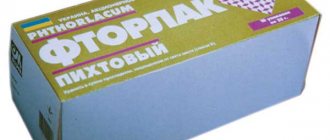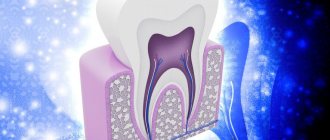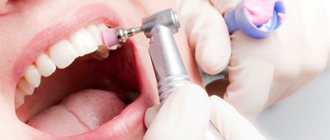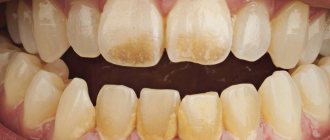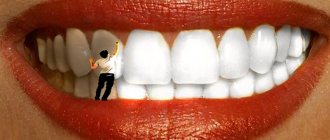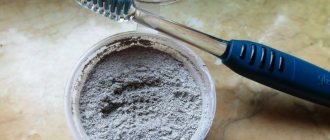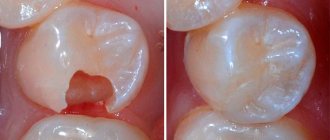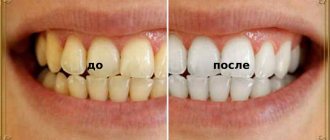Author of the article:
Soldatova Lyudmila Nikolaevna
Candidate of Medical Sciences, Professor of the Department of Clinical Dentistry of the St. Petersburg Medical and Social Institute, Chief Physician of the Alfa-Dent Dental Clinic, St. Petersburg
Drinking coffee and tea, smoking are the reasons for the formation of areas of enamel staining. The love of sweets, juices, fruits, combined with improper oral care, also leads to the fact that the enamel suffers: areas of demineralization, sensitivity, and caries appear. How to get rid of such unpleasant phenomena as dark pigment on teeth and sensitive enamel?
For this purpose, many different preparations are produced in the form of special toothpastes, gels, and varnishes. Let's talk about dental varnishes and alternative products. Some solve cosmetic problems and are intended for home use, others are used for therapeutic purposes and are applied by a doctor.
What is dental fluoridation?
Fluoridation of teeth is an effective method of strengthening tooth enamel and protecting teeth from caries.
A deficiency of fluoride and calcium in the human body inevitably leads to the destruction of dentin (the main part of the tooth) and the enamel covering it. The result is increased tooth sensitivity, a tendency to develop caries, and periodontal disease.
Fluoridation is a painless and absolutely safe procedure, the essence of which is to apply a thin layer of fluoride-containing compounds (fluorides) to the surface of the teeth.
After fluoridation, it is recommended not to eat for several hours (4-6 depending on the drugs used), and also not to drink too hot or, conversely, cold drinks. In addition, you should refrain from eating solid food for 24 hours. These recommendations are due to the possibility of damaging the protective layer of fluoride applied to the teeth. If deep fluoridation has been carried out, you can eat and drink immediately.
Kryolan
Paints of various shades are produced under the Kryolan brand. They are used to a greater extent to achieve a cosmetic effect. The drug does not have a significant therapeutic effect, since it does not contain antiseptics and is not able to preserve minerals.
The cost of enamel is about 680 rubles. The volume of the bottle is quite large - 12 ml. However, this paint cannot be used every day. It interacts with carbonated drinks and food. Therefore, enamel can only be applied for a few hours. Then it must be removed with a toothbrush.
Why coat your teeth with fluoride?
So what does fluoridation do? This method can be used by both adults and children to strengthen enamel and improve its strength properties.
Fluoride is an important element that not only makes enamel stronger, but also prevents the rapid proliferation of bacteria. Among other things, the resistance of teeth to an acidic environment increases, which means their surface becomes less susceptible to various types of destructive substances.
The fluoridation procedure must be repeated annually - then the teeth will be reliably protected from caries and not subject to premature destruction; The gradual leaching of calcium will stop, making the enamel stronger.
TIPS FOR STRENGTHENING ENAMEL
Taking care of your teeth should include proper nutrition. Without it, preventative medical procedures will be of little benefit. A complete menu to strengthen teeth enamel should include the following foods:
- dairy products: they all contain phosphorus and calcium;
- hard root vegetables - carrots, radishes, apples, cabbage: chewing activates the secretion of saliva, which cleans the crown of the teeth;
- parsley: essential oils of this plant suppress the activity of microorganisms, which affects the cleanliness and safety of teeth and the strength of their coating;
- green tea: tea leaves contain fluoride in their structure, which prevents the formation of plaque and the accumulation of bacteria on the teeth;
- chicken eggs and seafood: they contain iodine, which helps strengthen the enamel.
It is necessary to take care of strengthening teeth from the appearance of the first primary incisor. Those parents who consider their baby’s baby teeth to be temporary and unimportant are deeply mistaken. It is the health of baby teeth that determines the health of future molars.
After six years, a child definitely needs to prevent caries using the drug Fluorlak Omega and other gels/solutions for teeth. Treatment must be prevented by preventing diseases, then dental health will be strong and the enamel will be strong.
Types of fluoridation
Currently, fluoridation of teeth is carried out using two methods - simple and deep:
- Simple fluoridation . To carry out the procedure, special “spoons” are used that look like mouth guards, which are filled with a fluoride-containing composition and placed on the jaw for 10-15 minutes. To complete the full course, you need to conduct at least 10 sessions. An alternative option is simple fluoridation using a fluoride-containing varnish. It is applied with a special brush to the surface of the teeth and allowed to dry. The full course consists of 3-4 procedures, depending on the individual characteristics of the body and the drug used.
- Deep fluoridation . The main difference between this method and the previous one is the use of special enamel-sealing preparations. In addition, deep fluoridation requires careful preparation of teeth, therefore it is carried out exclusively in professional clinics. After the stage of cleaning the teeth, a special composition is applied to their surface using a tampon for 1-2 minutes, after which it is dried under the pressure of warm air. Then the surface of the teeth is stained with a swab dipped in calcium copper hydroxide milk, and then rinsed with clean warm water. The advantage of deep fluoridation is that the solution penetrates into the deep layers of enamel, making teeth much stronger. According to dentists, the effectiveness of deep fluoridation is 5 times higher than that of simple fluoridation.
Benefit
As already mentioned, the main goal of fluoridation is to strengthen tooth enamel. In addition, there are other advantages of this procedure:
- The sensitivity of the teeth is reduced, so there is no discomfort when consuming cold and hot food or drinks.
- The risk of developing caries is reduced due to a reduction in the number of pathogenic bacteria and increased resistance of teeth to an acidic environment.
- Fluoridation prevents calcium from being washed out of tooth enamel, making teeth stronger and stronger.
Harm
As you know, you need to know moderation in everything. Those who like to experiment with various fluoride-containing drugs need to know the following:
- Fluorides are toxic substances that in large quantities can cause serious harm to the human body. Therefore, if you prefer to use toothpastes with fluoride, then it is better to refrain from the fluoridation procedure. And vice versa - if you have coated your tooth enamel with fluoride, then you should choose toothpastes that do not contain this chemical element.
- Fluorosis is an excessive accumulation of fluoride in the body. Fluorosis leads to brittle bones, anemia, and neuralgic abnormalities. As for teeth, when fluoride accumulates excessively in them, the enamel begins to rapidly deteriorate, which invariably affects their appearance.
Reviews
Reviews about the use of varnish are contradictory. Some are satisfied with the resulting effect, while others note a lot of shortcomings. Particular attention is paid to the difficulties of self-application and the unnaturalness of the resulting layer.
If you have experience using dental varnish, you can share your opinion by leaving a review in the comments to this article.
If you find an error, please select a piece of text and press Ctrl+Enter.
Tags at home teeth whitening care
Did you like the article? stay tuned
Previous article
Removal of an impacted wisdom tooth: when recommended, features of the operation
Next article
Trainer T4K: who is it intended for, how to use it?
Fluoridation of teeth during pregnancy
During the period of bearing a child, most of all nutrients and minerals from a woman’s body go to the formation of the skeleton and muscle tissue of the unborn baby. Due to calcium deficiency during pregnancy, tooth enamel is destroyed, so fluoridation during this period is very useful. However, before applying fluoride to your teeth, you should have your mouth examined and consult an experienced dentist.
It is important to remember that severe toxicosis is the main contraindication to the procedure, so it is best to plan a trip to the dentist for the 2-3 trimester, when the pregnant woman’s health improves. During breastfeeding, the fluoridation procedure will also not be superfluous.
How does remineralization occur?
Every day our body is exposed to the negative effects of various factors. The process of weakening enamel can be started due to poor nutrition, poor drinking water, regular overexertion and a general lack of organic substances.
When pathogenic flora begins to develop in the oral cavity, the mechanism of natural remineralization of teeth, which works continuously under normal conditions, is disrupted; the leaching of mineral elements begins. The process is called “demineralization,” and if it is not stopped, carious disease and a number of other pathologies can develop.
Remineralization of tooth enamel is the opposite of demineralization. Remineralization can be achieved through restorative procedures that will restore strength to dental tissue and increase its resistance to pathogenic bacteria. There are several recovery options:
- Natural remineralization of teeth: replenishing the balance of biologically significant elements through the consumption of foods high in calcium and fluoride, and additional oral hygiene procedures.
- Artificial remineralization: saturation of enamel using remineralizing drugs. It is carried out both in the dental office and at home.
Contraindications and indications
To the question “When should you resort to dental fluoridation?” there is no clear answer. Dentists suggest performing it for children and adults as a preventive measure for caries, but there are other indications for coating teeth with fluoride-containing compounds:
- Increased sensitivity. As a rule, it manifests itself in the form of discomfort when eating cold foods or drinks, fresh fruits or vegetables. Fluoridation helps strengthen the enamel, thereby reducing dentin sensitivity.
- Tendency to develop caries. If you often visit dentists for dental treatment, then fluoridation is an excellent way to extend the life of your fillings and also prevent the formation of new enamel damage.
- Recent gum disease.
- Accumulation of a large amount of yellow plaque at the base of the tooth (above the gum).
- The fluoridation procedure is also carried out after removing braces.
- For children 6 years of age and older, fluoridation is recommended to prevent tooth decay and to maintain overall dental health.
Contraindications include only individual intolerance to certain elements of fluorine-containing formulations, as well as an excess of fluoride in the body. If the patient lives in an area where the fluoride content in the water is quite high, in this case the doctor will most likely offer you other preventative procedures to protect and strengthen the enamel.
Stages of the procedure
Regardless of the chosen fluoridation method, this procedure includes the following steps:
- Oral hygiene. This can be either a full professional cleaning (removal of plaque and tartar), or a simple treatment with antiseptic dental compounds. The tooth surface must be clean before applying fluoride-containing compounds so that the mineral substances can protect the enamel.
- Thorough drying with warm air.
- Depending on the chosen method of fluoridation, either fluoride-containing varnish is applied to the teeth, or a mouth guard with a special paste is put on for 10-15 minutes.
- During deep fluoridation, the surface of the teeth is covered with an enamel-sealing liquid, which is thoroughly dried and carefully shaded. After 1-2 minutes, rinse the oral cavity.
It is also important to understand that fluoridation is advisable only on healthy teeth, so before the procedure it is imperative to sanitize the oral cavity.
Prof. hygiene with 20% discount
Moscow
"Colordent"
White varnish-paint for teeth "Colordent" contains antiseptic substances. This product whitens enamel by 10 tones and preserves minerals in tooth tissue. The drug is packaged in a pen bottle. It is easy to use. Even a child can apply this varnish on his own, since the composition of this product is safe.
Colordent is applied every day and removed with a toothbrush. This product takes quite a long time to dry, and its effect is short-lived. The cost of paint in pharmacy chains ranges from 1,500 to 2,000 rubles.
Fluoridation of teeth at home
Currently, preparations for fluoridation of teeth can be purchased in pharmacies or specialized clinics. Fluoride varnish is an effective remedy for strengthening teeth at home, but it should be used carefully and only after consultation with your dentist.
In order for fluoridation to bring visible results, it is necessary to take care of the cleanliness of your teeth. Next, you need to strictly follow the instructions included with the drug. Fluoride varnish should be used in courses - 3-4 procedures.
The most common way to strengthen tooth enamel is to use toothpastes containing fluoride. However, it is worth remembering that you cannot use these products for a long time - you need to alternate them from time to time with other drugs that do not contain fluoride.
Celebrity White Flash
This white tooth paint works great to brighten enamel. At the same time, it has a pronounced therapeutic effect - it strengthens dental tissue and preserves minerals. It can be used to prolong the effect of professional whitening.
The cost of paint is about 500 rubles. It is packaged in a pen-shaped bottle. It is important to remember that this product takes a long time to dry. After applying it, you must refrain from eating and drinking for 1 hour.
Fluoridation and silvering: what is the difference?
The silvering method is the treatment of teeth with preparations containing silver nitrate. This method of combating caries is prescribed to the youngest children - up to 3 years old. The procedure is quick and painless: saliva is removed from baby teeth, then they are impregnated with a silver preparation. Silvering is used only at the initial stage of caries - “white spots”, and can stop the development of the disease, but does not cure it. In addition, a big disadvantage is the darkening of the teeth as a result of the procedure.
In dentistry, this method is now almost never used, giving way to a more effective fluoridation technique. The procedure is as simple as silvering, but it has advantages over the latter: fluoridation not only prevents the development of caries, but also strengthens tooth enamel.
